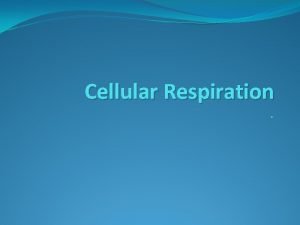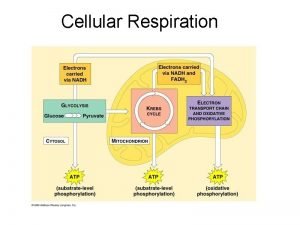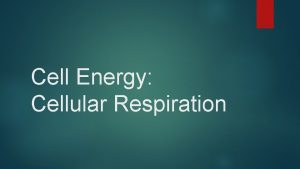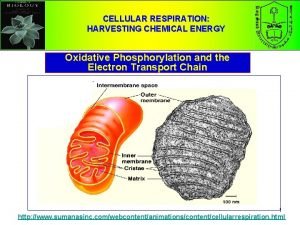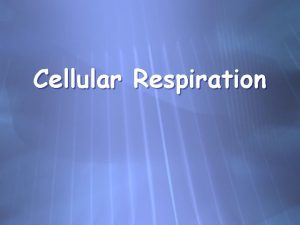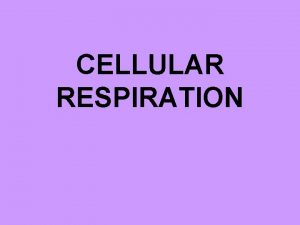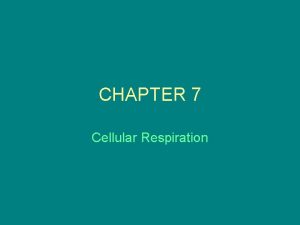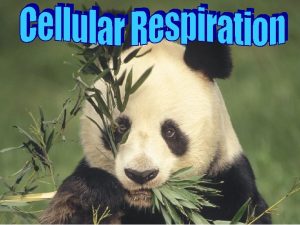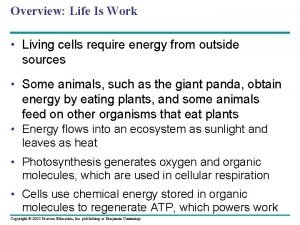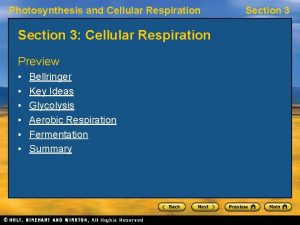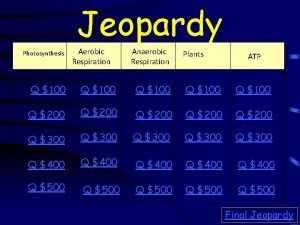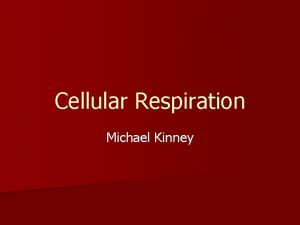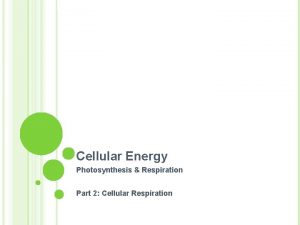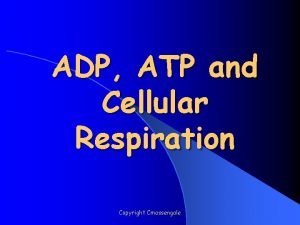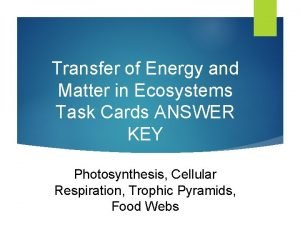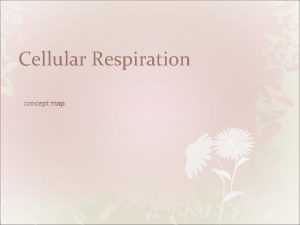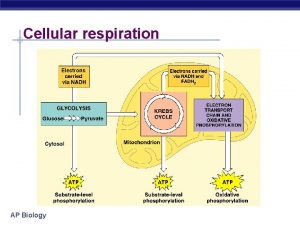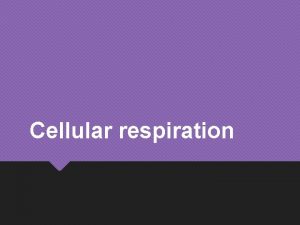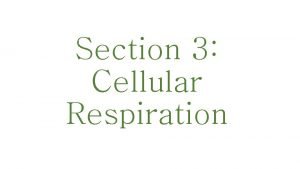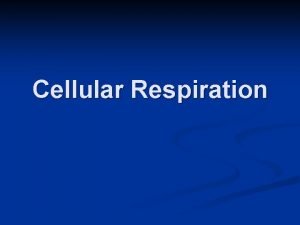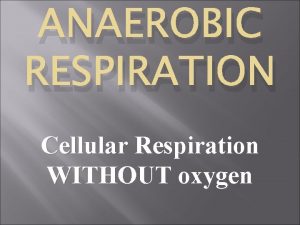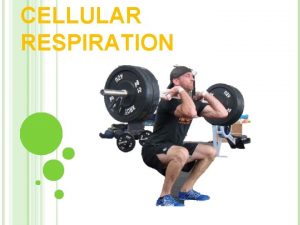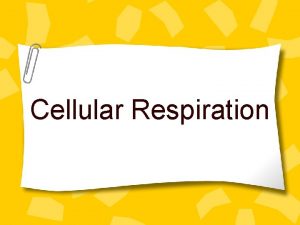Cellular respiration What is cellular respiration Respiration occurs

















- Slides: 17

Cellular respiration

What is cellular respiration? Respiration occurs in the mitochondria of the cells in all organisms, all of the time. Respiration is the breakdown of glucose to produce energy in the form of ATP (adenosine triphosphate).

Mitochondria Recap • Rod-shaped structure to increase the surface area for diffusion. • Inner membrane is folded to create cristae which further increase the surface area available for cellular respiration. • The liquid matrix provides a medium for reactions.

The breakdown of glucose may be aerobic or anaerobic. Aerobic respiration: • Requires oxygen • Produces large amounts of ATP per glucose (38 net ATP) Anaerobic respiration: • Occurs in the absence of oxygen • Produces a small amount of ATP per glucose (2 net ATP).

Purpose of cellular respiration To produce ATP is the “energy molecule” used to fuel all chemical reactions within a cell such as: Protein synthesis Movement of cilia/ flagella

Aerobic Respiration: Overview Aerobic respiration requires oxygen for the complete breakdown of glucose into carbon dioxide and water. The energy released is in the form of ATP and heat energy. Ne ed to kn o w Reactants Products Word equation: glucose + oxygen carbon dioxide + water + ATP + heat Chemical equation: C 6 H 12 O 6 + 6 O 2 -----> 6 CO 2 + 6 H 2 O + 38 ATP + heat

Aerobic Respiration: Overview There are three main enzyme-controlled chemical pathways in aerobic respiration: 1. Glycolysis 2. Krebs Cycle 3. Electron Transport Chain

Aerobic Respiration: 1. Glycolysis • Glycolysis= The breakdown of glucose • Takes place in: Cytoplasm • Glucose broken down into two pyruvate molecules. • 2 ATP are used, however 4 ATP are made net gain of 2 ATP

Aerobic Respiration: 2. Krebs Cycle • Takes place in: matrix of mitochondria • Pyruvate (in the form of acetyl-Co. A) is fed into a complex biochemical cycle. • Extensive rearrangement of the molecule occurs with CO 2 molecules and H atoms being produced as by-products. 1. CO 2 is a waste product diffuses out of the mitochondria and cell. 2. The H atoms, are important for the next step of photosynthesis and are picked up by the carrier molecules NAD and FAD (co-enzymes) to be taken to the electron transport chain. • 2 ATP are produced during this process.

Aerobic Respiration: 3. Electron transport chain • Takes place in: cristae of mitochondria • H atoms from the co-enzymes NADH and FADH 2 are ionised (H 2 2 H+) and their high-energy electrons are passed along a series of acceptor molecules called cytochromes which are attached to the cristae. • As the electrons move along the electron transport chain, a proton gradient is created and this provides energy for the enzyme ATP synthase to produce ATP from ADP (a phosphate bond added to ADP to form ATP i. e. ADP +Pi ATP).

Aerobic Respiration: 3. Electron transport chain Oxygen is necessary because it is the final electron acceptor. The electrons combine with the hydrogen ions and oxygen to create water as a byproduct of the reaction

Net ATP produced from aerobic respiration= 38 ATP

Anaerobic Respiration: Overview Anaerobic respiration occurs in the absence of oxygen. Only glycolysis can take place, therefore only 2 ATP molecules are produced from each glucose molecule This is a very inefficient way to make energy!

Anaerobic Respiration: In Animals Ne ed to k no w • Occurs when oxygen is in short supply- (prolonged exercise or very fast sprints). • The pyruvate formed in glycolysis is broken down into lactic acid. • Lactic acid build-up causes muscle fatigue and can be painful. • Muscles need to rest to allow replenished supplies of oxygen to breakdown the lactic acid into water and carbon dioxide. • We cannot survive on anaerobic respiration for very long due to the build-up of this lactic acid waste product. Word equation: glucose lactic acid + ATP (small amt) Chemical equation: C 6 H 12 O 6 -------> 2 C 3 H 6 O 3 + 2 ATP

Anaerobic Respiration: Fermentation Ne ed to k no w Yeast and bacteria rely solely on anaerobic respiration • In yeast, the pyruvate is broken down into ethanol (C 2 H 5 OH) and carbon dioxide in a process known as fermentation. • The small energy yield of ATP molecules is sufficient to meet the lifestyle needs of these organisms. Word equation: glucose ethanol + carbon dioxide + ATP + heat Chemical equation: C 6 H 12 O 6 2 C 2 H 5 OH +2 CO 2 + 2 ATP + heat

Similarities and differences between aerobic and anaerobic respiration

Factors which affect the rate of respiration The body’s energy demands Temperature • Rate of respiration will increase up to a maximum as the metabolic demand from the cells of tissues increases. • The amount of O 2 needed (and the amount of CO 2 produced) increases, thus the breathing rate increases to compensate. • The build-up of CO 2 will slow down the rate of respiration.
 The process of cellular respiration occurs in *
The process of cellular respiration occurs in * Cellular respiration occurs in
Cellular respiration occurs in Electron transport chain cellular respiration
Electron transport chain cellular respiration Electron transport chain summary
Electron transport chain summary Where does cellular respiration take place
Where does cellular respiration take place What type of cell performs cellular respiration
What type of cell performs cellular respiration Redox reaction in cellular respiration
Redox reaction in cellular respiration Hans krebs
Hans krebs Total atp produced in cellular respiration
Total atp produced in cellular respiration Section 3 cellular respiration
Section 3 cellular respiration What is the word equation for cellular respiration
What is the word equation for cellular respiration Labeled mitochondria cellular respiration
Labeled mitochondria cellular respiration Cellular respiration organelle
Cellular respiration organelle Electron carriers in cellular respiration
Electron carriers in cellular respiration Where does cellular respiration take place
Where does cellular respiration take place Cellular respiration equation
Cellular respiration equation Chemical equation for cellular respiration
Chemical equation for cellular respiration Cellular respiration ap biology
Cellular respiration ap biology
